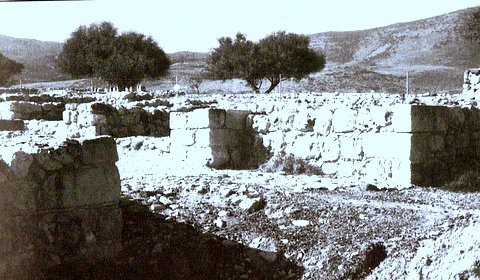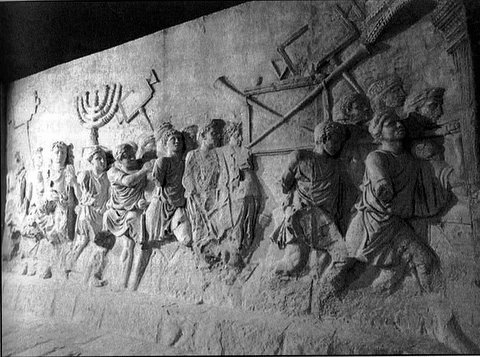-3-
Seven Scenes From Holy History
The history of Israel is unlike the history of other nations. Since Israel is very special to God and since the nation figures prominently in God’s worldwide redemptive program, the history of Israel may be more accurately called “redemptive history,” “salvation history,” or even “holy history.”
Trying to summarize the history of Israel is like trying to summarize the history of the world. Because of God’s great redemptive plan, the Jews have been dispersed to almost every place on this globe. They have also lived in virtually every time frame in recorded history.
Although the land of Israel was given to them as their dwelling place, they have lived outside the land much more than they have lived in it. This fact impacts the study of Israel’s history to a considerable degree.
Let us take a quick look at the redemptive history of Israel as we attempt to picture it in seven critical events. These events are:
1) The call of Abram
2) Birth of the nation (deliverance from Egypt and giving of the law)
3) Conquest and settlement of Canaan
4) Rise of the Davidic kingship and its messianic implications
5) First dispersion and restoration, including Daniel’s view of history
6) Coming of the Messiah
7) Second dispersion and restoration, including the Holocaust
SCENE ONE: THE CALL OF ABRAM
Abram was one of the most remarkable men this world has ever known. He was remarkable in that he introduced the whole pagan world to the unique and incredible concept of the one true God.
We can imagine that in the pagan land where Abram lived, he often heard the screams of babies as they were burned alive in the fires at pagan altars. He must have often passed the pagan temples, which were the churches and synagogues of his day. As he passed them, he must have seen the open and flagrant adultery and homosexuality, because this was the way people worshipped their gods in Abram’s time.

An ancient altar for Baal worship at Megiddo
People worshipped many gods. In fact, every nation had its own panoply of pagan gods. Ancient Babylon, in the area where Abraham lived, is said to have had 300 gods of heaven and another 600 of earth. This did not count the many spirits, who were also worshipped.1
The gods of the past were capricious and demonic. Many times the gods were more unrighteous than men.
God desired to redeem mankind from this dismal environment of idolatry. For God to redeem a whole world it was necessary for him first to redeem a man, then a family, and finally a whole nation.
Let us look back to the days of Abram. In his day, what was to be the land of Israel was a part of “the Fertile Crescent.” On one end of the crescent was the future land of Israel, God’s proposed redemptive base in the world. On the other end of the crescent was Abram, the man who would bring the nation of Israel into being, and who would become the redemptive “father” of all believers everywhere. His name, Abram (exalted father), was thus changed to Abraham (father of a multitude).
We read in the Bible that Abraham was from Ur of the Chaldees in Babylonia. He hailed from the land of the two rivers, the Tigris and Euphrates. Abraham first lived in Ur and then later his family moved to Haran. While in Haran, God called him to leave his father’s house and his country and to go to Canaan (Gen. 12:1-3). The time of his journey was probably around 2000 BC, and Abraham was seventy-five years old, a time when most people retire to their rocking chairs.
Abraham crossed the Euphrates, and its tributaries, and set out for the land to which God had called him. In so doing, he inadvertently supplied the name to his future people, the Hebrews. The root for their name in the Hebrew language is eber, and it means “to
cross over.”
Abraham crossed over from his idolatrous and depraved world to become the man of God and to bring forth a people to God. The followers of Abraham today, who number into the multiplied millions, are likewise people who “cross over.” They cross over the sea from Egypt (flesh) into the realm of the Spirit. They cross over the Jordan to possess the heavenly country God has given.
Father Abraham arrived in Canaan with Sarah his wife, his nephew Lot, and all their possessions, including their servants (Gen. 12:4-5). His first recorded visit in the land was at Shechem (today’s Nablus). There, by the great tree of Moreh, among strangers, God appeared to him and promised to give the land to his offspring (Gen. 12:7). The everlasting drama of the land and the man had begun.
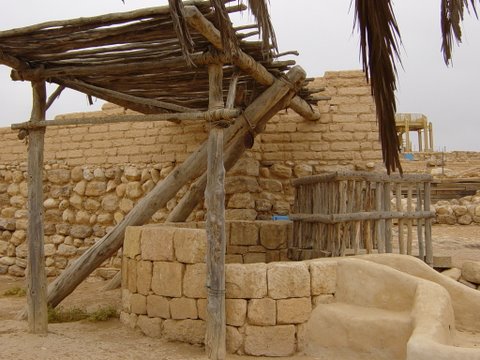
Abraham’s Well at Tel Sheva in southern Israel
Although Abraham was a remarkable man, he was still very much a human being like all the rest of us. There were times when his faith wavered. There were other times when he stood as a giant in the earth. His faith must have wavered when God told him to leave Haran and his father’s house. Somehow, Abraham took his nephew Lot along with him (Gen. 12:4). Lot caused Abraham much heartache. The children of Lot, Ammon and Moab (present day Jordan), have continued to vex Israel to this time.
Abraham was promised a son by faith, although he was very old and his wife Sarah was far past the age of childbearing. Apparently Abraham had some slight doubts about this promise. At Sarah’s urging he finally took her handmaid Hagar and from her was born Ishmael. Today, over a billion Muslims in the world look to Ishmael as their spiritual father. For the last thirteen hundred years the Muslims have bitterly persecuted the true spiritual seed of Abraham.
On other occasions Abraham stood as a mighty tower of faith. One of these occasions particularly stands out. After Abraham and Lot were separated, the latter was taken captive as a result of a Babylonian raid into the area. If Abraham had been like most of us he would have probably said, “Thank God, my troubles are over. Lot has finally gotten what he deserves!”
Abraham didn’t react that way. He called his little group of 318 servants together. We can imagine that Abraham had to give some quick instruction to those of his men who were not trained as warriors. He might have said something like this: “Now guys, this is a bow, and this is an arrow. Please remember to keep the feathers next to you when you try to shoot the thing!”
It was no doubt a motley crew that Abraham had as an army. Who would think of taking such an army to fight one of the greatest powers of the ancient world. But Abraham was a man of faith in the Mighty God.
As he led his tiny army through the brush that night in northern Galilee, something incredible happened. The Babylonian army went crazy. We don’t know what they saw or heard. I doubt if we would want to know. They may have heard the war cries of a million angelic soldiers and they may have seen fiery chariots racing through the skies. They panicked and ran for their lives. Abraham and his men collected the vast booty, including Lot and all that belonged to him, and returned home victorious.
This was to be the first of many such strange victories that Abraham’s people would gain through future centuries. Little would pagan enemies understand that they were not just fighting against Abraham or his seed, but against the mighty God of Israel and his eternal redemptive program.
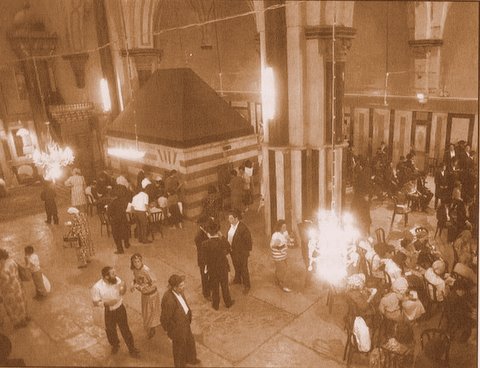
Tombs of Abraham and the Patriarchs in Hebron
(Courtesy Israel Information Office)
Abraham became the father of Israel and of all those who believe (Rom. 4:11). His son Isaac carried on the redemptive history to the next generation. After him, Jacob carried on the tradition and brought forth the twelve tribes of Israel.
Through the envy of his brothers, one of Jacob’s sons, Joseph, was sold into Egypt as a slave. In time, through God’s providence, he rose to great heights of power, becoming second only to Pharaoh. Joseph, through prophecy, had foretold a seven-year famine in the whole land. He had also predicted seven years of plenty before the famine. As a result, Joseph was placed in charge of grain storage and abundant provisions were laid up
in Egypt.
At last, to stave off famine, the whole house of Israel, some seventy souls, came to sojourn in Egypt. The people were treated kindly at first, but after four hundred years, the people were made slaves and they cried out to the God of Abraham.
SCENE TWO: BIRTH OF THE NATION (Deliverance from Egypt and giving of the Law)
It seemed that Moses (Mo-shea in Hebrew) had missed his calling in life. He had a great beginning, being adopted into the family of Pharaoh, king of Egypt. Now he had fallen from grace in the Egyptian court, and quite frankly had also fallen on bad times. He now spent his days herding sheep and goats on the back side of the desert of Sinai.
Moses once thought that he would deliver his oppressed people from Egypt, but now that idea must have seemed remote. Moses’ life was now well spent, seeing that he was already about 80 years old.
However, God had not forgotten Moses, nor had he forgotten his people suffering down in Egypt. God knew that the sojourn in Egypt was necessary for the Children of Israel. It had also been necessary for Moses. It seems that the faithful of every age have had to endure the “Egypt experience.” On one occasion even Abraham had to go down into Egypt and sojourn there for a time. Now the whole nation of Israel was stuck in Egypt.
It was to be a type of God’s redemption and a messianic type as well. God would later speak of Jesus in Matthew 2:15 saying: “Out of Egypt I called my son.” The separation from Egypt is pictured throughout the scripture as a separation from this world and a consecration to God.
The Living God, who had heard the cries of his captive people, now paid a visit to lonely Moses in the desert of Sinai. There Moses saw the Living God, the “I Am” of scripture. He is the only man who ever did so and lived to tell about it.
God sent stammering Moses along with his brother Aaron down to Egypt to pay a call on perhaps the most powerful monarch of the ancient world. Moses went with the message “Let my people Go!”
Again we need to use our imaginations just a little as we picture this shepherd from the back side of the desert coming before mighty Pharaoh. What happened when Moses delivered this message? Pharaoh and his whole court probably had some good belly laughter. After this, Pharaoh said something equivalent to “No way Mo-shea!”
Pharaoh’s refusal was the beginning of one of the most unusual periods in the history of the world. God with a mighty hand began to plague Egypt.
The story of the deliverance from Egypt is one of the classic dramas of all time. Never before in history was a nation born in the midst of another nation (Deut. 4:34). Never before had the world seen such a miraculous visitation with astounding supernatural displays.
Awesome and fearful plagues fell on Egypt. There were plagues of blood and frogs. Mrs. Pharaoh couldn’t go to the bathroom at night without stepping on the squishy, croaking things. There were gnats, insects, pestilence, and boils. We can imagine mighty Pharaoh waddling out gingerly to speak to Moses, having a boil on each foot, and perhaps another one on the very place where he would have sat down.
There was hail, locusts, and darkness, devastating the land. Finally there was the death of the firstborn in Egypt. That night the people of Israel were spared while Egypt’s firstborn all died. Through Moses, God had instructed his people to slay the Passover lamb and place its blood on the lintels and doorposts of their houses. When this last plague came, the people of Israel were spared. At that last plague the whole house of Israel was freed
from bondage.
The whole drama of salvation is pictured vividly in the plagues of Egypt, particularly the slaying of the firstborn. The slaying of an unblemished lamb, the blood upon the doorpost, the passing over of the death angel and the following deliverance would always stand out as vivid types of God’s salvation through the Messiah. To this day the Jews in their Passover seder annually recount much of this salvation history.
Later, as Israel was leaving Egypt and as they were in the awkward position of trying to cross the Red Sea without boats, Pharaoh changed his mind and pursued them.
That night as Moses held his staff over the sea and as the horses of Pharaoh pawed and neighed a short distance away, the east wind began to blow and the sea stood up in columns revealing the dry ground beneath. The people of Israel then began to pass through the sea on dry ground.
At this, one would think that Pharaoh would have dismounted his chariot, bowed his face to the ground and repented of his evil. Instead, in his insane rage, he dared send his army after the Israelites.
When Moses and all the people had passed through the sea, and as the whole army of Pharaoh was now in the midst of the sea, the waters suddenly closed upon them. That night there was something like twin tidal waves coming together with such velocity that Egyptian horses and their riders were hurled through the air and into the sea (Exo. 15:1).
Too often we read the accounts of scripture without truly getting the picture of the awesome works of God. We need again to stop and meditate until we can smell the sea water and hear the cries of the drowning.
That morning as the bodies of Egyptians washed up on the shores, all the women sang with tambourines. Miriam led them in this chorus: “Sing to the LORD, for he is highly exalted. The horse and its rider he has hurled into the sea” (Exo. 15:21).
Moses then led the people which God himself describes as “stiff necked” (Exo. 32:9) into the wilderness of Sinai. It was there that the nation, or at least the remnant of the nation, was molded into the people God desired. There in the desert God fed them daily with manna from heaven. In the desert they were given commandments from the mouth of God. In all the history of the world, no people had ever heard God’s voice out of the fire and smoke (Deut. 5:26). This experience made a lasting impression upon the
Jewish people.
The generation that came out of Egypt was not able to enter the land of Canaan due to their lack of faith and vision. However, the following generation began to enter the land that God had long before promised to Abraham and to his children.

A wilderness area where Israel likely ventured
(photo credit Yoni Gerrish)
SCENE THREE: CONQUEST OF CANAAN
Moses led the people forty years in the wilderness and, finally he led them to the Jordan River. However, God did not permit him to lead them any further. He did help them to experience their first great victories in battle, as they fought against Sihon, king of Heshbon (today’s Jordan) and Og, the king of Bashan (today’s Golan Heights). As a result of these two battles the people began to inherit the land on the east side of the Jordan River. The tribes of Reuben, Gad and the half-tribe of Manasseh settled in this area.
After the death of Moses, his able assistant Joshua took command. Joshua led the people miraculously over the Jordan River. Again, they walked through on dry ground, even though the river was at flood stage.
Joshua then led the people in a smashing victory over the city of Jericho. It is thought by some today that Jericho is actually the oldest city in the world. There is presently even a sign to that effect on the outskirts of the city. Even by Joshua’s time, Jericho was heavily fortified and virtually impossible to conquer. Through a great miracle the mighty walls of Jericho fell down. There is no trace of city walls on the ancient mound of Jericho today.
After the miraculous victory at Jericho, Joshua proceeded to cut the land of Canaan in two just a few kilometers north of Jerusalem. In swift succession he defeated the principal cities and centers of influence in the land of Canaan. These cities included Ai, Makkedah, Libnah, Lachish, Gezer, Eglon, Hebron, and Debir. Joshua accomplished this in one campaign, because the Lord God fought for Israel (Josh. 10:42).
Later, Joshua fought a confederation of northern kings led by Jabin, king of Hazor. Their warriors were as numerous as sand on the seashore (Josh. 11:4). Hazor was one of the mightiest cities in Canaan and was actually the gateway city into the land from the north. This confederation of kings was also defeated, and Hazor was then burned by Joshua. The burn line from Joshua’s time can still be seen in this ancient city.
The land was then divided among the remaining tribes and settlement was begun. The battles for the land, however, would continue on for many generations. Sometime after Israel’s settlement in the land, the Philistines, a sea people from the area of Crete, began to settle along the seacoast in the Gaza area. They were destined to become one of Israel’s greatest antagonists.
In appraising the conquest of Canaan by the Israelites we must stop and marvel. Canaan was a well-developed area with greatly fortified cities that had been built over many centuries. The Israelites were a band of desert wanderers with little skill in the type warfare required to conquer fortified cities.
The conquest was a series of miracles. God had promised this land to Abraham’s seed long before. As he had promised, God came to fight for Israel. Even nature was incorporated on several occasions to fight against the Canaanites. We see that hornets went on the offensive against them (Josh. 24:12). Hailstones fell from heaven (Josh. 10:11). Even “…the stars fought, from their courses…” against the northern commander, Sisera (Jud. 5:20).
The entry of Israel into the land of Canaan has been variously set by scholars, with dates ranging from 1550 to 1200 BC. It is clear that the actual settlement was not without its problems. After the death of the great leader Joshua, the people began to turn away from the true God to serve the idols of the Canaanites. Swift punishment came from God, and he allowed them to be harassed by various enemies. When the people cried out to God he sent judges to deliver them from their foes.
Probably some of the most famous of these judges were Deborah and her military assistant Barak (Judg. chs. 4-5), who delivered Israel from another league of Canaanite kings in the north; Gideon (Judg. chs. 6-8), who delivered the people from the Midianites; and Samson (Judg. chs. 13-16), who began to deliver the people from the Philistines.

The spring where Gideon formed his small army
In time, the people of Israel began to long for a king like the other nations. Again, God heard their requests and gave them their first king, Saul. Saul began to make a serious attempt to war against the Philistines, who were at this time imposing their rule upon Israel. At last, through his own disobedience, Saul was killed in battle by the Philistines on Mount Gilboa.
SCENE FOUR: RISE OF THE DAVIDIC KINGDOM (and its Messianic implications)
Even before Saul’s death God had chosen the next king of Israel. This time it was a man after God’s own heart (1 Sam. 13:14). Of all the kings who have ever ruled on this earth, David was unique. Even as a child he was able to play on his harp and soothe the deranged King Saul. As a mere child he went forth to fight mighty Goliath, the Philistine giant. This giant was over nine feet tall and was heavily armed. David came against him with a sling and stone, and with the mighty power of God. The giant was slain and Israel won another of her miraculous victories.
David was gifted as a mighty warrior and leader of men. Saul soon began to envy David, and for many years thereafter, David and his men hid out as fugitives in the various wilderness areas of the country.
After the death of Saul on Mount Gilboa, and the humiliating defeat of Israel by the Philistines, David became king. He first ruled at Hebron in the south, but he later moved to consolidate his kingdom in Jerusalem about 998-995 BC. For the most part, David ruled very wisely over the people of Israel.
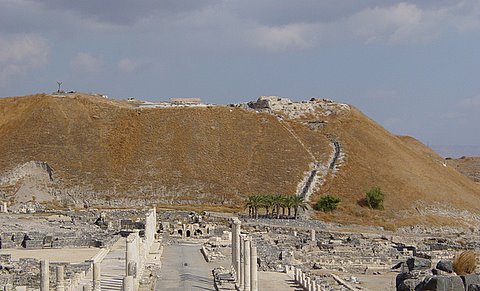
A view of the ancient tel (city) of Bet Shean. The bodies of Saul and
Jonathan were hung here after the defeat on Mt. Gilboa.
During his reign the kingdom was greatly expanded to include most of the land God had promised Israel. With the direct help of God he scored numerous victories over Israel’s persistent foes. For the first time, even the Philistines began to wilt away before the onslaught of David.
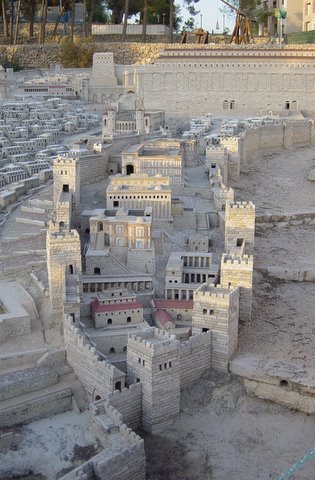
The City of David, at Jerusalem’s ancient model.
David was not only a mighty warrior; he was an extremely sensitive spiritual person. While other kings of the earth, no doubt, immersed themselves in politics, David immersed himself in God. His many Psalms bear witness to this. In Psalm 63:1, David cries out:
O God, you are my God, earnestly I seek you; my soul thirsts for you, my body longs for you, in a dry and weary land where there is no water.
Of all men on earth, David may have been the most urgent seeker after God. He worshipped God with a whole-hearted devotion. He longed to dwell in God’s house (Psa. 23:6). He danced unashamedly before the Lord (2 Sam. 6:14). David began a revolution in worship that has had a tremendous affect upon Jews and Christians alike. His Psalms have comforted Israel and the Church for three thousand years.
It is interesting that as the end-days come upon us, the style of David’s worship is returning to the Church. We may assume that it will also return to Israel. This is in full accordance with the words of the prophet:
In that day I will restore David’s fallen tent. I will repair its broken places, restore its ruins, and build it as it used to be (Amos 9:11).
Once he was settled in his kingdom, David greatly desired to build God a house. Since the days of the wilderness wanderings the “house” of God had been a tabernacle or tent. David spoke to the prophet Nathan about his desire. However, God did not permit David to build his house or Temple. Instead, Nathan informed David that God desired to build a house for him instead.
The divine promises to King David are unique. There has never been a king in history who received such promises. God said to David in 2 Samuel 7:16:
Your house and your kingdom will endure forever before me; your throne will be established forever.
Hence, we have in David the beginnings of an eternal Messianic kingdom. It was not just a natural kingdom, but also one with deep spiritual implications. In time, David the king died. Later, his son Solomon reigned and died. Finally in our day the natural line of David has all but disappeared from among men. Yet, the kingdom of David continues through his heir, the Messiah.
The kingdom was split in 928 BC upon the death of Solomon. The northern section was called Israel, and the southern section became known as Judah. The kingdom generally disintegrated in both these areas as the people were prone to mix their unique faith with that of their pagan Canaanite neighbors.
It was in this turbulent period that the mighty voices of Israel’s prophets began to thunder out, starting with those of Elijah and Elisha.
By the eighth century BC the voice of Israel’s prophets reached a high water mark in Isaiah, Micah and others. Later in 627 BC, Jeremiah began his prophetic work in the southern kingdom of Judah.
The prophets of Israel have had far-reaching influence and have, over the centuries, touched people in many nations of the earth.
SCENE FIVE: ISRAEL’S FIRST DISPERSIONS AND HER RESTORATION (Including Daniel’s unique view of history)
It was becoming more and more apparent that Israel was called to live in the middle of a super highway. The only way she could live there was by faith and absolute obedience to God. Unfortunately, both of these qualities were waning in the land. By 722 BC, the northern kingdom of Israel was so weakened by idolatry that it fell to the Assyrian king, Shalmaneser, and the people were carried into captivity.
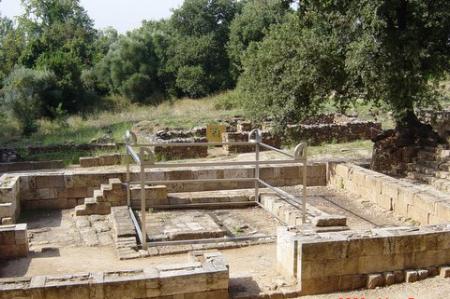
Remains of the altar to false gods that Israel constructed at Dan
The Assyrians, who had a policy of displacing rebellious kingdoms with people from other conquered provinces, brought in alien people to settle the land. Thus, we have the beginnings of the Samaritans. The ten northern tribes of Israel who were dispersed in the land of Assyria became known in history and legend as the “Ten Lost Tribes.” Although these tribes have disappeared from history, the prophets still speak of their resurrection in the end-days (Hos. 1:10-11). It is of interest that several people groups claiming descent from these tribes have immigrated to Israel in recent years.
The southern kingdom of Judah continued until it was finally conquered by Nebuchadnezzar of Babylonia in 586 BC. The beautiful Temple built by Solomon, David’s son, was destroyed and the people were also carried away captive. However, this time they were carried to Babylon. Unlike the dispersion of Israel, the people of Judah soon had an opportunity to return and experience a restoration in the land, just as the prophets had foretold.
In Mesopotamia the suzerainty soon passed from Babylon to the Media-Persian Empire. The policy of the Persians was opposite to that of the Assyrians and Babylonians, in that they sought to restore captive peoples to their native lands. In addition, God had specifically spoken to King Cyrus that he might let the people of Judah return home. God had even called Cyrus “his anointed” (Isa. 45:10).
We can be certain that Daniel, who rose to great power both in the Babylonian and Persian empires, had some influence on these events. Daniel prayed earnestly for restoration and he also had opportunities to speak with these kings.
As a result, the decree of Cyrus allowing the exiles to return was issued in 536 BC (Ezra 1:1-4). Shortly thereafter the first wave of Jewish exiles began the journey home under Zerubabbel.
We can sense the divine favor riding upon the small company of some forty-two thousand who returned. Although we do not know the names of those who preferred to remain in Babylon, we certainly know the names of many who came home. We even know how many donkeys returned. There were 6,720 of them and they are recorded in God’s book (Ezra 2:67). At this, we might assume that it is better to be a donkey and return home to Israel, than to remain and be a prince in Babylon.
When we look at this whole period, we have to marvel at how God has worked in history. This sets him apart from the pagan gods, who all failed to work in history. In fact, history worked on them. History consigned their images to its dustbins and their names are long since forgotten. However, the name of the God of Israel is an everlasting memorial (Exo. 3:15). His mighty acts have been repeated by the lips of millions through the ages.
Upon arrival home, the exiles rebuilt the altar and began also to rebuild the Temple. Their work was greatly hindered by the surrounding peoples in the land, and it was finally stopped altogether by decree of the new king. It was not until the prophetic work of Haggai and Zechariah in 520 BC that the work began again. The Temple was finally completed in 516 BC.
In the latter days of the Persian Empire, God intervened once more in history to elevate a young Jewess to the heights of imperial majesty by making her Queen of Persia. Queen Esther later found it necessary to go before her husband, the all-powerful monarch, in a bid to rescue her own Jewish people from the plots of evil Haman.
The historian Josephus sheds some interesting light on her visit to the king. After fasting three days, Esther approached the king without his bidding. In ancient Persia this usually resulted in the death sentence. Josephus says that as Esther saw the king sitting on the throne and looking sternly at her, she fainted, whereupon the king sprang from his throne and lifted her up, placing his scepter in her hand and reassuring her. 2 Esther saved her people and her great influence may well have helped later in re-establishing the people of Israel in the land.
Perhaps it was somehow a result of her influence that two Jewish luminaries from the Persian Empire came to give much needed assistance to the returned exiles. The first was Ezra the Scribe. Ezra did much to mold Israel into the “people of the Book,” a title by which they are known even to this day.
Later, Nehemiah, who was cupbearer of the Persian king Artaxerxes I, came to Israel with the specific commission from God to rebuild the wall of defense around Jerusalem. He faced immense persecution from the people of the land, the Samaritans and Arabs. Nevertheless, about 444 BC, the wall was completed. Judah was at last firmly established, awaiting the crucial period of history leading up to the appearing of her Messiah.
SCENE SIX: COMING OF THE MESSIAH
Israel’s most famous son was born during the turbulent period at the turn of the millennium. At this time, due to the oppression of the Romans, messianic expectations were at an extremely high pitch. This unique period in history was chosen by God long before and became known as “the fullness of time” (Gal. 4:4-5). During this special time frame God gave his son Yeshua (Jesus) to the world.
He was not born in the royal palaces of Herod, but according to the prophecy of Micah 5:2, he was born in the nearby town of Bethlehem. He was born in a lowly stable. His birth and life as the Savior of Israel and of the world are without parallel.
The coming of this long-awaited Messiah was God’s utmost intervention into human history. The Messiah was not just man, but he was the unique combination of God and man, or the God-man. At last, God had come to live in his world. Jesus fulfilled the word of Isaiah spoken many centuries before in Isaiah 7:14, “…The virgin will be with child and will give birth to a son, and will call him Immanuel [God with us].
Jesus, or Yeshua as he is called in the Hebrew language, fulfilled numerous other prophecies in the scriptures. He was born of the tribe of Judah (Gen. 49:10). He was of the house of David and heir to that house forever (Isa. 9:7 & Luke 1:32-33)
His eternal nature is set forth in Psalm 45:6-7:
Your throne, O God, will last for ever and ever; a scepter of justice will be the scepter of your kingdom. You love righteousness and hate wickedness; therefore God, your God, has set you above your companions by anointing you with the oil of joy.
Also, in Psalm 110:1 we read:
The LORD says to my Lord: “Sit at my right hand until I make your enemies a footstool for your feet.”
We do not believe that God was talking to himself. In these passages God was talking to his Son, the Messiah.
The historical events surrounding Jesus’ birth also correspond to the Hebrew scriptures. He was preceded by a forerunner (Isa. 40:3-5; Luke 3:2-6). According to Daniel’s prophecy he was born prior to the destruction of the Second Temple (Dan. 9:25-26). Even the slaughter of infants in the Bethlehem area was foretold (Jer. 31:15; Matt. 2:16-18). After his birth he was taken to Egypt because of the wrath of Herod (Hos. 11:1;
Matt. 2:14-15).
Years later when Jesus began his ministry, he was declared to be God’s son (Psa. 2:7; Matt. 3:17). He was not another god, but the physical manifestation of the one true God. Jesus conducted his ministry very much in the pattern of Moses: he fed the people miraculously, he brought healing to them and gave them a new law, one to be written on their hearts. Thus he fulfilled the word of God in Deuteronomy 18:15:
The LORD your God will raise up for you a prophet like me from among your own brothers. You must listen to him.

The Sea of Galilee where Jesus conducted most of his ministry
Yeshua spoke in parables (Psa. 78:2-3; Matt. 13:34-35), bound up the brokenhearted (Isa. 61:1; Luke 4:18), he healed the blind, deaf, dumb and lame (Isa. 35:5-6; Luke 4:18-19). He was adored by small children (Psa. 8:2; Matt. 21:15). Although the religious leaders of his day could remember nothing in scripture spoken about a Messiah from Galilee (Jn. 7:52), he fulfilled Isaiah 9:1-2 which says:
Nevertheless, there will be no more gloom for those who were in distress. In the past he humbled the land of Zebulun and the land of Naphtali, but in the future he will honor Galilee of the Gentiles, by the way of the sea, along the Jordan— The people walking in darkness have seen a great light; on those living in the land of the shadow of death a light has dawned.
Jesus spent a great deal of his ministry on the northern and northwestern shores of the Sea of Galilee. He even made his base at nearby Capernaum, situated on the Way of the Sea (Via Maris). At Capernaum, along that famous road, the Light of the World was manifested.
The synagogue at Capernaum where Jesus did much teaching
(photo credit Peggy Steffel)
Unfortunately for Israel, Yeshua was not accepted, but was in fact rejected and despised by the leaders (Isa. 53:3; Jn. 1:11). His good news of salvation was not believed by them (Isa. 53:1; Jn. 12:37), although the common people seem to have heard him gladly. The Jewish leaders did not know the time of their visitation, and now it would be hidden from their eyes (Luke 19:42-44).
Jesus was betrayed by his close friend (Psa. 41:9; Lk. 22:47) for thirty pieces of silver (Zech 11:12; Matt. 26:14-15).
During his trial before the religious court he was abused and spat upon (Isa. 50:6; Matt. 26:67). He was tried and accused by false witnesses (Psa. 35:11; Mk. 14:57). To these accusations he opened not his mouth (Isa. 53:7; Mark 15:4-5).
Later he was crucified with criminals as the scripture foretold (Isa. 53:12; Mark 15:27). He was pierced through his hands and his feet (Zech. 12:10; Jn. 20:27). He was mocked and reproached (Psa. 22:7-8; Luke 23:35). But no bone of his was broken (Psa. 34:20; John 19:32).
In that dark hour on the cross, even God the Father found it necessary to turn his face away from him (Psa. 22:1; Matt. 27:46). Yet, while he hung there on the cross he prayed for his enemies (Psa. 109:4; Luke 23:34).
An ancient tomb with a rolling stone door
After his agonizing death, the Roman soldiers cast lots for his clothing just as the Psalmist had spoken long before (Psa. 22:17; Matt. 27:35-36). He was then taken from the cross and buried with the rich as Isaiah had prophesied (Isa. 53:9; Matt. 27:57-60). He did not die as a malefactor, but as a redeemer. Isaiah 53:5 speaks of his death in this way:
But he was pierced for our transgressions, he was crushed for our iniquities; the punishment that brought us peace was upon him, and by his wounds we are healed.
His death was not the end. God would not leave his Messiah in Sheol, but he was raised from the dead (Psa. 16:10; Mark 16:6). After appearing on many occasions to his disciples, even to more than five hundred followers on one occasion, he ascended to the Father and took his seat at the Father’s right hand (Psa. 68:18; Mark 16:19; 1 Cor. 15:6).
It is the fervent belief of the Church that he will come again according to scripture. His feet will stand again upon the Mount of Olives at Jerusalem (Zech. 14:4). He will come when his people can at last speak in sincerity the words of Matthew 23:39:
For I tell you, you will not see me again until you say, “Blessed is he who comes in the name of the Lord.”

The Mount of Olives where Jesus will stand at his return
Today, as we look back on the history of two thousand years, we realize that a truly momentous event took place. We are living on a visited planet. The Almighty God, the King of the Universe, came to live on earth as a man. The shock waves of that visit continue to reverberate through the world and through history.
SCENE SEVEN: ISRAEL’S SECOND DISPERSION AND RESTORATION
Within a generation of Jesus’ death, a disaster of immense magnitude befell Israel. This disaster was predicted by Jesus as he was led to his death in Luke 23:28-29:
… Daughters of Jerusalem, do not weep for me; weep for yourselves and for your children. For the time will come when you will say, “Blessed are the barren women, the wombs that never bore and the breasts that never nursed!”
He also spoke of this event as his disciples were admiring the beauty of the Temple. Jesus warned them sternly by saying in Luke 19:43-44:
The days will come upon you when your enemies will build an embankment against you and encircle you and hem you in on every side. They will dash you to the ground, you and the children within your walls. They will not leave one stone on another, because you did not recognize the time of God’s coming to you.
During the years from AD 66-73, Israel became embroiled in a futile revolt to throw off the Roman yoke. As the revolt continued, Jerusalem was at last surrounded and shut up by the enemy. The situation became very grave for its inhabitants. The historian Josephus tells of the deaths of countless thousands from hunger. He even relates how a mother roasted her own child and dined upon it. 3
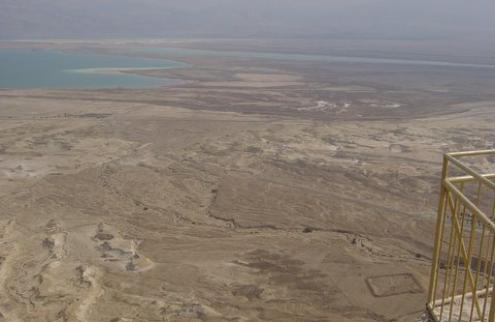
The fortress of Masada looking down on the Dead Sea. This was Israel’s last stand against the Romans. One of the rectangular Roman camps can still be seen in the right foreground.
At last the city walls were breached. Then the unthinkable happened, the beautiful Temple was set on fire and destroyed. Later the Romans proceeded to burn and sack the city. Josephus again describes the awful slaughter as one in which streams of blood ran down the streets in such volume as to actually put out the flames.4 After the fall of Jerusalem the war lingered on until Masada, the last stronghold, fell in AD 73.
The Arch of Titus in Rome, showing captured Temple items brought from Jerusalem
(Courtesy Israel Information Office)
Israel’s agony was not ended. Some years later, Simon Bar Kokhba was proclaimed by many to be the messiah. In the years AD 132-135, he led a second revolt against Rome. Once more the Romans cruelly ended this rebellion, but not before multiplied thousands were killed and the slave markets glutted once more with Jews.
At this time, Rome was determined to put an end to Jewish rebellions. In derision, the land was renamed Syria Palestina. They rebuilt the city of Jerusalem as a pagan city and renamed it Aelia Capitolina. Hadrian, the Roman Emperor, then prohibited the practice of Judaism and Jews were even forbidden to come near the city.
After the earlier defeat of Jerusalem in AD 70, the Jews had made a valiant attempt to continue on in the land. The Sanhedrin was established near the Mediterranean coast in Yavne. From there the sages of the Torah continued their work. After the second revolt, however, the center of Judaism moved to the Galilee. Rome was determined to punish the leaders of the revolt it was necessary for many of them to hide out in the Galilee for
several years.
By the year 210, the work on the Mishna, the compilation of Jewish oral tradition, was completed and soon thereafter the first generations of Talmudic scholars were being produced in Israel. Nevertheless, Jewish life in the Holy Land was a flickering candle. In a few generations the center of Judaism would shift from Israel to Babylon once again. It would for the most part remain in Gentile lands for the next fifteen centuries.
In the early fourth century, the Roman ruler Constantine declared himself to be a Christian and Christianity began to hold sway in the Middle East. This further encouraged the Jews to disperse to other nations.
In the seventh century, Islam arose and one of its first acts was the conquest of Palestine including Jerusalem. With the exception of the brief interlude of the Crusades at the turn of the first Christian millennium, the Muslims would control Palestine until the twentieth century.
After their unsuccessful revolts against the Romans, the Jews began their dispersion to the farthest reaches of the Roman Empire. They now began to make their homes in places like Alexandria, Tarsus, Ephesus, Byzantium, and Rome. By the year 300, they had settled in all parts of the empire except Britain. 5
After the fall of the Roman Empire in 476, the Jews began to play a leading part in world trade. They traveled to the farthest reaches of the empire and even as far as India and China through their involvement in the spice trade. 6
As the vast areas of Europe became civilized, the Jews settled in these areas also. In early years a thriving Jewish civilization flourished in Spain. The Jews settled in France and Germany. Unfortunately, the lot of the Jews in “Christian” Europe would never be secure. Although they made great and lasting contributions to these societies, time and time again they were expelled from different cities and nations.
When the new world was discovered, a Jew was one of the first two people to set foot upon it. The Jews followed the wave of discovery and colonization to the ends of the earth and to the islands of the sea. This in itself was a fulfillment of prophecy. It is said in Isaiah 11:11:
In that day the Lord will reach out his hand a second time to reclaim the remnant that is left of his people from Assyria, from Lower Egypt, from Upper Egypt, from Cush, from Elam, from Babylonia, from Hamath and from the islands of the sea.
During all their long centuries in gentile lands the Jews suffered persecution in many forms and were driven from one land to another. They suffered under Crusades, Inquisitions, blood libels, forced conversions, forced baptisms, pogroms, and slanders of many types. Under Islam their lot was only slightly improved.
In time, the virulent anti-Semitism, which had flourished in the Church since the fourth century, blossomed into severe persecution under the Nazis, beginning in 1933. During the Holocaust that followed, six million Jews lost their lives. From the ashes of that greatest of all disasters, the modern nation of Israel began to rise once more.
After World War II, the survivors made their way to Palestine to join with the many others who had come earlier from the persecutions of Russia and other places on the globe. The word of the Lord was fulfilled once again:
This is what the LORD says: “The people who survive the sword will find favor in the desert; I will come to give rest to Israel” (Jer. 31:2).
On November 29, 1947, the United Nations approved the partition plan allowing Israel to become a nation once more after almost two thousand years.
Israel was declared a state in May 1948 and following this act she was forced into an agonizing War of Independence with her many Arab neighbors. At the close of this war the nation of Israel was successful and once again firmly established among the family
of nations.
STUDY QUESTIONS:
How does holy history, or redemptive history, differ from regular history?
Was it unfair for God to almost destroy Egypt in order to bring Israel out of bondage? Why?
What kind of things happened when pagan forces fought Israel in the Bible? Do you suppose such things still happen in Israel’s wars today?
What are some qualities David had that enabled him to become a type of God’s coming Messiah?
How does Daniel’s view of history differ from most views today?
In what ways were Jesus’ claims different from that of all other great religious leaders?
NOTES
1. E.A. Wallis Budge, Babylonian Life and History (New York: Dorset Press, 1992) p. 110.
2. William Whiston, The Works of Josephus, Complete and Unabridged (Peabody, MA: Hendrickson Publishers, Peabody, MA, 1987), p. 301.
3. Whiston, The Works of Josephus, Complete and Unabridged, p. 737.
4. Whiston, The Works of Josephus, Complete and Unabridged, p.748.
5. Martin Gilbert, Jewish History Atlas (Jerusalem, Tel Aviv, Haifa: Steimatzky, Ltd, 1969, fourth edition 1992) p. 17.
6. Martin Gilbert, Jewish History Atlas, p. 22.

